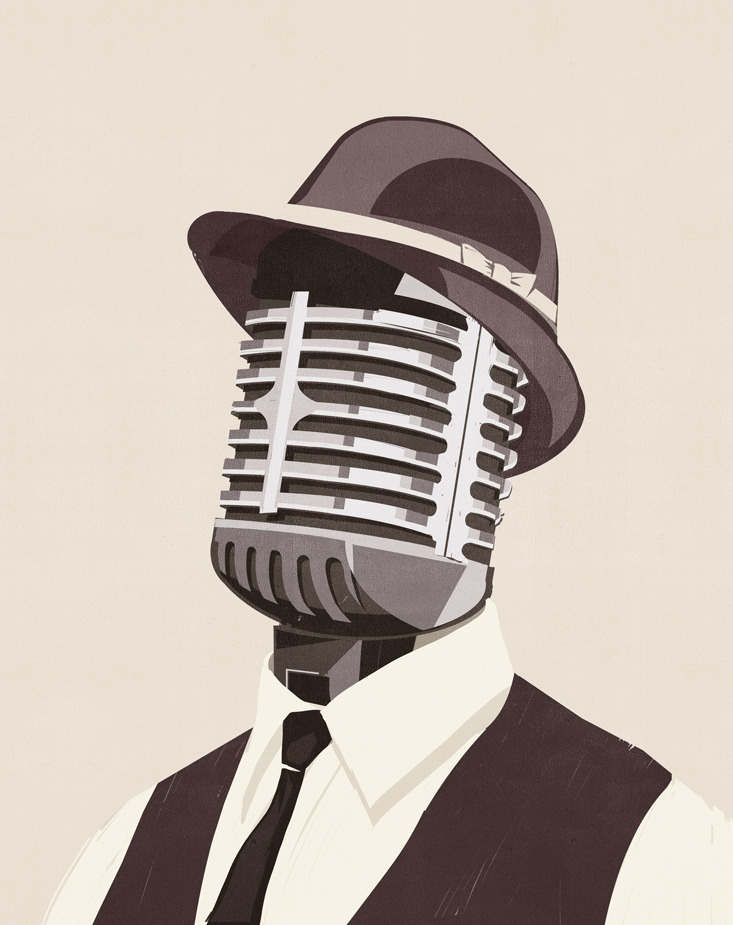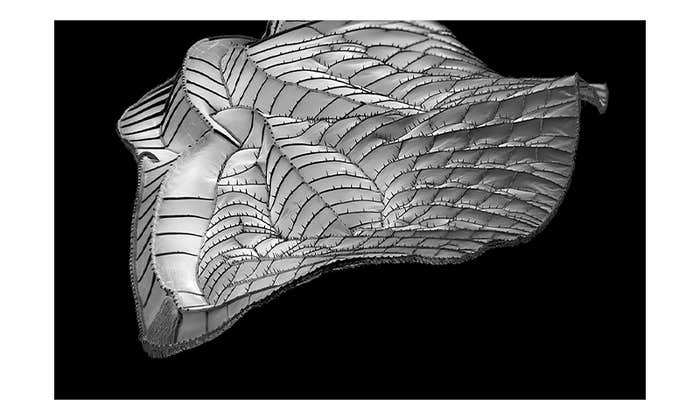During the last months of my mother’s life, as she ventured further from lucidity, she was visited by music. In collusion with her dementia, her hearing loss filled her consciousness with musical hallucinations. Sometimes welcome, more often not, her musical visitations were vivid, yet segmented and tattered. She would occasionally comment on the singers. On rare occasions she would identify the performer.
Mitch Miller, who wrote oppressively cheerful arrangements of popular songs from the 1950s, seemed to command a prominent role in her hallucinations.
At times she would spontaneously hum fragmentary melodies, apparently singing along to the music she was hearing. But since the music was inaudible to me, all I heard were occasional vocalizations. I felt compelled to transcribe these wordless shards of her past for posterity. Here are the notes I transcribed on Jan. 16, 2010, played on a piano.
With lots of patience and some luck, I was able to trace these fragments comprised of ascending melodic leaps, and among my mother’s more persistent and recurrent visitations, to their origin, a popular song from the 1940s called “Cruising Down the River.”
“Cruising Down the River” was number one on the Billboard charts the week my brother was born. I found this profoundly poignant. I suspect “Cruising Down the River,” like all the music my mother was imagining, bore a strong link to significant moments in her life. Imprisoned by immobility, isolated by near-deafness and dementia, it was as if her musical hallucinations provided the last glimmer of her past—faint beacons that helped her navigate her clouded sensorium. My mother’s musical hallucinations stoked the narrative of her life, providing salient autobiographical markers that elicited lost memories, and referential associations that momentarily buoyed and channeled her emotions.
If, as Picasso wrote, “Everything you can imagine is real,” then the very real music my mother was hearing must have constituted a reality quite distinct from what we, at her bedside, were privy to.
As a composer and researcher in cognition and music, I have been thinking about my mother’s hallucinations and what they might tell us about the nature and role of music today. Neurological research has shown that vivid musical hallucinations are more than metaphorical. They don’t just feel real, they are, from a cognitive perspective, entirely real. In the absence of sound waves, brain activation is strikingly similar to that triggered by external auditory sounds.1,2 Why should that be?
Music, repetitive and patterned by nature, provides structure within which we find anchors, context, and a basis for organizing time. In the prehistory of civilization, humans likely found comfort in the audible patterns and structures that accompanied their circadian rhythms—from the coo of a morning dove to the nocturnal chirps of crickets. With the evolution of music a more malleable framework for segmenting and structuring time developed. Humans generated predictable and replicable temporal patterns by drumming, vocalizing, blowing, and plucking. This metered, temporal framework provides an internal world in which we construct predictions about the future—what will happen next, and when it will happen.
This process spotlights the brain itself. The composer Karlheinz Stockhausen hyphenated the term for his craft to underscore the literal meaning of “com-pose”—to put together elements, from com (“with” or “together”) and pose (“put” or “place”). When we imagine music, we literally compose—sometimes recognizable tunes, other times novel combinations of patterns and musical ideas. Toddlers sing themselves to sleep with vocalizations of musical snippets they are conjuring up in their imagination. Typically, these “spontaneous melodies,” as they are referred to by child psychologists, comprise fragments of salient features of multiple songs that the baby is piecing together. In short, we do not merely retrieve music that we store in memory. Rather, a supremely complex web of associations can be stirred and generated as we compose music in our minds.
Today, amid widely disseminated music, we are barraged by a cacophony of disparate musical patterns—more often than not uninvited and unwanted—and likely spend more time than ever obsessing over imagined musical fragments. The brain is a composer whose music orchestrates our lives. And right now the brain is working overtime.

The neurological reality of the music hallucination may have dawned in 1964. In a classic study from that year, researchers asked subjects to close their eyes and imagine hearing Bing Crosby sing “White Christmas.” Following 30 seconds of silence, over half of the subjects said they had heard the song playing in their head. Five percent said a record had been playing. The psychologists concluded that an auditory image could be generated from imagination alone.3
Modern brain scanners have confirmed the “White Christmas” test. In one 2012 study, subjects were shown lyrics of popular songs. Half of the subjects heard the song as they read the lyrics, and the other half imagined the song as they read them. Based on fMRI data, the auditory cortex, responsible for processing sound, was active in both groups. The auditory cortex also acts as an intersection to the rest of the brain. Subjects who imagined the songs triggered increased activity in the prefrontal cortex, the supplemental motor area, the intraparietal sulcus, and the cerebellum, brain areas associated with how we perceive and navigate the world.4
Evolution has wired us to hear components of sounds that do not have a physical acoustical basis. The cochlea is a biological system that effectively decomposes a sound into its constituent frequency components. It converts instantaneous changes in air pressure into components that stimulate the hair-like filaments along the inner ear’s basilar membrane, which aids in translating sound vibrations into electrical signals. The activated filaments produce electrochemical signals that are transmitted to the auditory cortex. The individual components of an individual sound are re-integrated and perceived as a singular event—in part by nature of their harmonicity (that is, their constituent components are related in integer ratios), and, in part, by their temporal synchronicity, which integrates many components into a perceived individual event.
The brain is a composer whose music orchestrates our lives. And right now the brain is working overtime.
Curiously, we perceive and interpret a sound’s fundamental frequency even when that component is absent, as long as we hear a few harmonically related components. That’s because the harmonics produce a range of subjective tones from the beat frequencies between them. These tones create a sense of the pitch of the fundamental frequency. This illusory effect, called the “missing fundamental,” is a critical aspect of auditory perception. Our ability to comprehend and appreciate old analog devices like worn records and transistor radios is because we perceive the illusory missing fundamental.
Consider the telephone. The fundamental frequency of the male voice is between 85 hertz (cycles per second) and 155 hertz. The fundamental frequency of the female voice lies between 165 hertz and 255 hertz. Telephone technology, however, limits the range of transmission frequencies to between 400 hertz and 3.4 kilohertz. So how do we recognize familiar voices, and classify unfamiliar voices by age, gender, and other factors bearing acoustic signatures?
Fundamental frequencies, like the 85 hertz to 155 hertz of the male voice, are generally defined as the lowest common denominator of harmonics. The human voice, like a guitar string, resonates, producing harmonics—from which we sense pitch—that ascend; in this case, right into the transmission frequencies of the phone. The high-range frequency of the phone is the region in which vocal formants—the resonant peaks of the voice—enable discrimination of vowels and phonemes. The lower range is key in characterizing the voice and identifying the speaker. So even though the fundamental frequency is omitted, it is audible. Our brains flesh out the tones.
There are other instances in which we hear one or more nonexistent tones. The early 18th-century Italian composer, violinist, and music theorist, Giuseppe Tartini noted his ability to create a “third tone” (terzo suono) while playing two tones simultaneously on his violin. Tartini was hearing a “combination tone” perceived at the frequency that was the difference of the two frequencies played. Tartini noted that the clear perception of this nonexistent sound was useful in tuning, since it was audible only with particular frequency relationships. To this day, string players often rely on “Tartini tones” when tuning.
Throughout the ages, musicians have capitalized on our active, associative minds. By inserting silent gaps in songs and instrumental music, they cause us to fill in the gaps with our inner hearing.5 “Music,” wrote Claude Debussy, “is the space between the notes.”

Our ability to derive meaning from the slightest input of sound has obvious evolutionary benefits. Survival depends on acting fast and not sitting around and wondering whether it is a lion or just the wind, rustling through the brush. Often, sounds seem to stir a subconscious voice that wants to tell us something important. Once, in a moment of lucidity, during which my mother was cognizant of hallucinating, she began to sing Irving Berlin’s duet “You’re Just In Love (I Wonder Why)” from Call Me Madam, which begins, “I hear singing.”
Although my mother didn’t continue past the first line, later that day Ethel Merman’s response to the first verse invaded my musical consciousness:
Although I hadn’t consciously thought of the song for decades, I vividly recall my excitement as a child when I realized that the two melodies together create perfect counterpoint.
It seems that tune was lurking in the recesses of my memory. Once dredged up into my conscious mind, it had a deep effect on me. It elicited warm memories of my mother during my childhood and one of my earliest musical insights, perhaps the one that set me on my course as a professional musician.
With the weighty role of organizing temporality, music permeates our brain. A side effect of imagining music is it can get stranded in our memory, a highly susceptible network of neurons and dendrites, axons and neurotransmitters. So rather than being experienced as a bona fide listening experience, songs, tunes, or more likely, fragments of them, become obsessive thoughts that are difficult, if not impossible, to displace. This “involuntary musical imagery,” rightly known as an “earworm,” is spontaneously perceived and occupies our thoughts through incessant recurrence.
The biggest culprit seems to be music that we’ve heard recently. Roughly eight seconds of a catchy segment will resurface often at a seemingly inopportune moment. Generally the imagined snippet is recognizable. Often the hearer consciously associates the segment with a recent audition of the music or is consciously aware of an association between what likely triggered the earworm—perhaps a key word in the title or lyrics, or an association between a person or place and a song. An earworm might be triggered by the suggestion of a salient rhythm or melodic segment from other music or ambient sounds.
Autobiographical memory, a store of events and experiences from our individual lives, often plays a role in which songs will invade the psyche. Most often, these invasions will occur at moments of relatively low arousal and stimulation. In moments of sensory deprivation, when we suppress or exclude external stimuli, we are likely to project internalized percepts and awareness.
While some musical images are uninvited, obtrusive, and bothersome, they are, ultimately, instances of unbridled creativity.
It’s a haunting quality of the human brain that a writer no less than Edgar Allan Poe noticed. In an 1845 essay “The Imp of the Perverse,” Poe wrote, “It is quite a common thing to be annoyed with the ringing in our ears, or rather in our memories, of the burthen of some ordinary song, or some unimpressive snatches from an opera. Nor will be the less tormented if the song in itself be good, or the opera air meritorious.”
Recent research shows earworms thrive in the digital world. There is a correlation between the frequency of use of mobile music devices and the susceptibility to earworm infliction.6 Earworms are also contagious and the rise of social media and the popularity of personalized ringtones have provided a breeding ground for infestation. Although there is conflicting evidence regarding the demographics of earworm affliction, it seems that they occur more frequently, are more bothersome, and are more difficult to control in individuals with neurotic traits.7
The unprecedented quantity of music that we are subjected to undoubtedly exacerbates earworm intrusions. The other day a car pulled up beside mine while I was stopped at a traffic light. The pounding bass from the subwoofer in his “boom car” rattled my windows and nerves. Just as the light turned green, I was left with Eminem’s line, “My pen’ll go off when I half-cock it.”
In my mind, the quirky rhythmic turn that the song, “Rap God,” takes on the phrase “after the fact,” morphed into the sacristan’s line, Badi, quand’esce chiuda (“Be sure to close up before you leave”) from Tosca, which I saw for the umpteenth time the night before.
Puccini has a penchant for writing memorable melodies that become fodder for tormenting earworms in the days that follow a performance. But the rhythmic transformation from “Rap God” to Tosca was unnerving, and for days I flipped back and forth between them.
It seems plausible that the dramatic rise in the volume (both quantity and loudness) of musical sound that assaults our senses—much of it redundant, repetitive, and repeated often—accounts for a rise in earworm disease.1 Our ability to attend to, and find meaning in, sensory input depends upon our ability to filter out the unwanted.8 Noise challenges our world of meaning and diminishes our ability to discriminate. We have evolved to resist confusion and seek clarity. Failing that, in the presence of sensory indiscrimination, we are prone to create illusory percepts, seeking patterns when none exist.
While some musical images are uninvited, obtrusive, and bothersome, they are, ultimately, instances of unbridled creativity. In a 1981 essay, “Music, Mind, and Meaning,” cognitive scientist Marvin Minsky told us that “ideas come from processes obscured from us and with which our surface thoughts are almost uninvolved.” Paul McCartney, for instance, was so convinced that “Yesterday” came to him in a dream that he felt that it had to have been written by another composer. And Robert Schumann was convinced that Franz Schubert dictated a theme from his Violin Concerto to him.
The highly patterned nature of music, and the dedication of particular regions of the brain to encode abstractions of pitch, temporal structures, and patterns, also constitute the intrinsic nature of the experience and enjoyment of music. Musical schemas include the bifurcation of western tonal music into major and minor modes—each of which embodies a distinct character and affective association, as well as the generalizations of metrical structures that allow us to differentiate between a march and a waltz. These generalizations allow us to create predictions and expectations even when we hear music that is unfamiliar.
In the end, whether we are conscious of an idea’s origin, whether it comes in a dream, or invades our consciousness as an earworm, our ability to form and maintain musical images is a fundamental mental process. Perhaps as surrender to the noise and chaos that increasingly pummels our auditory system, musical imagery guides us, cajoles us, and sometimes coerces us, to peer inwardly, unravel, and understand the patterns of our lives.
Jonathan Berger is the Denning Family Provostial Professor in Music at Stanford University. His current research focuses on musical expectations and listener engagement. His sixth string quartet premiered this January in New York and Philadelphia by the St. Lawrence String Quartet. He is currently working on a full-length theatrical work commissioned by the National Endowment for the Arts for the Kronos Quartet.
References
1. Zatorre, R.J. & Halpern, A.R. Mental concerts: Musical imagery and auditory cortex. Neuron 47, 9-12 (2005).
2. Schaefer, R.S., Morcom, A.M., Roberts, N., & Overy, K. Moving to music: effects of heard and imagined musical cues on movement-related brain activity. Frontiers in Human Neuroscience 8 (2014). Retrieved from doi: 10.3389/fnhum.2014.00774
3. Barber, T.X. & Calverley, D.S. An experimental study of “hypnotic” (auditory and visual) hallucinations. The Journal of Abnormal and Social Psychology 68, 13-20 (1964).
4. Herholz, S.C., Halpern, A.R., & Zatorre, R.J. Neuronal correlates of perception, imagery, and memory for familiar tunes. Journal of Cognitive Neuroscience 24, 1382-1397 (2012).
5. Kraemer, D.J., Macrae, C.N., Green, A.E., & Kelley, W.M. Musical imagery: Sound of silence activates auditory cortex. Nature 434 (2005). Retrieved from doi:10.1038/434158a
6. Williamson, V.J., et al. How do earworms start? Classifying the everyday circumstances of Involuntary Musical Imagery. Psychology of Music 40, 259-284 (2011).
7. Floridou, G.A., Williamson, V.J., & Müllensiefen, D. Contracting earworms: The roles of personality and musicality. Proceedings of the 12th International Conference on Music Perception and Cognition and the 8th Triennial Conference of the European Society for the Cognitive Science of Music (2012).
8. Hyman, I.E., et al. Going gaga: Investigating, creating, and manipulating the song stuck in my head. Applied Cognitive Psychology 27, 204-215 (2013).






























